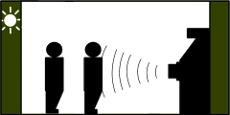Key Takeaways
- People are traditionally a challenging target for ultrasonic sensor
- MaxBotix® Inc., offers ultrasonic proximity sensors that reliably detect people, making them an effective people sensor solution.
- Proximity information is minimally affected by sensor cross-talk.
People Detection
Many
ultrasonic sensor applications require the user to detect people in an environment. MaxBotix® Inc.,
provides ultrasonic sensors that reliably detect people, and our sensors have been installed in a large number of people detection applications. While every ultrasonic sensor carried by MaxBotix® Inc., has the ability to detect people, simply purchasing a sensor with 10 meter ranging capabilities does not mean the sensor will detect a person all the way out to 10 meters. Your application has the best chances of success when you put careful consideration into the sensor selection process for effective people detection.
Ultrasonic Sensors Related to this Article
Target Types
Although
two objects may be of similar size and shape, they may not be equally detected by an ultrasonic sensor. Large, flat, or solid objects reflect more sound back to the sensor than small, rounded, or hollow objects. Consider a cinderblock wall as a good example of large, flat, and solid. Compared to that wall, a person is not all that large, flat, or solid. A person reflects much less sound than a wall which makes it harder to detect people out to the same range as a cinderblock wall. While our ultrasonic sensors can range to wall-like targets all the way out to their specified maximum range, people have a more limited maximum range. In general, people are detected in very much the same area as a one inch diameter dowel would be detected. Understand that the clothing, body build, and environments surrounding the ultrasonic sensor affect the stability and ranging capabilities. With this in mind, the area in which a person is detected by our ultrasonic sensors usually falls between beam patterns A and B that we provide for each of our sensors, making them effective human proximity sensors.
While our ultrasonic sensors can range to wall-like targets all the way out to their specified maximum range, people have a more limited maximum range. In general, people are detected in very much the same area as a one inch diameter dowel would be detected. Understand that the clothing, body build, and environments surrounding the ultrasonic sensor affect the stability and ranging capabilities. With this in mind, the area in which a person is detected by our ultrasonic sensors usually falls between beam patterns A and B that we provide for each of our sensors, making them effective human proximity sensors.
Benefits of an Ultrasonic Proximity Sensor
Range
information is not always the best choice for every application. When detecting people, proximity information (whether someone is in front of the ultrasonic sensor or not) may better suit the task. The main benefit to the proximity data is that it is more resistant to sensor cross-talk or sensor-to-sensor interference than range information. This allows the installation and deployment of a larger number of
ultrasonic sensors before worrying about cross-talk.
When more than one sensor is ranging in an environment, the additional ultrasonic noise can make the range information from our ultrasonic sensors less stable. Proximity information can often be a good fit for such applications because it gives a more stable response. Do note that this proximity information indicates that something has been detected within a given range but does not provide the range to the object. All of our standard sensors have a range output available, but a number of our sensor lines, for example our ProxSonar® lines, feature an additional proximity information output. This proximity information provides users with a digital high (1) low (0) logic level that corresponds to when a person is detected (1) or not (0). Our proximity sensors offer various preset trigger ranges, target acquire time requirements, and target release time requirements to meet the needs of most applications. Custom trigger distance, target acquire, and target release times can be set for a nominal NRE charge.  Consider the following example of a kiosk sensor in a mall. The kiosk owner may not want the kiosk to light up every time somebody walks past it but instead only want the kiosk to activate when somebody walks directly up to it. Applications where a target is intended to stand in front
Consider the following example of a kiosk sensor in a mall. The kiosk owner may not want the kiosk to light up every time somebody walks past it but instead only want the kiosk to activate when somebody walks directly up to it. Applications where a target is intended to stand in front of the
ultrasonic sensor to activate or trigger an event are great candidates for using the proximity data, especially when utilizing a proximity sensor to detect human presence.
Choosing the Right Ultrasonic Sensor
The primary factor that limits the range to which you can detect a person is the sensitivity of the ultrasonic sensor itself. Higher sensitivity corresponds to longer range detection of people, but at the same time higher sensitivity also means greater sensitivity to noise. Thus, the goal is to find the sensor that is just sensitive enough for your application to avoid any potential issue where your sensor is picking up interference from an outside noise source. If you are using one of our
ultrasonic sensors for
protected environments, the level of sensitivity can be determined by the EZ or AE designation at the end of the product name with EZ0/AE0 being the most sensitive and the EZ4/AE4 being the least sensitive.

On the other hand, if you are using one of our sensors for
non-protected environments from one of our WR sensor lines, many offer very similar detection zones. However, a number of sensors do have heightened sensitivity. Review the product datasheets to find a full listing of the WR sensors with heightened sensitivity. Our
Sensor Selection Guide is a great place to start when selecting a sensor for any application. If further help is needed please fill out the
"Help with Sensor Selection" form.
 While our ultrasonic sensors can range to wall-like targets all the way out to their specified maximum range, people have a more limited maximum range. In general, people are detected in very much the same area as a one inch diameter dowel would be detected. Understand that the clothing, body build, and environments surrounding the ultrasonic sensor affect the stability and ranging capabilities. With this in mind, the area in which a person is detected by our ultrasonic sensors usually falls between beam patterns A and B that we provide for each of our sensors, making them effective human proximity sensors.
While our ultrasonic sensors can range to wall-like targets all the way out to their specified maximum range, people have a more limited maximum range. In general, people are detected in very much the same area as a one inch diameter dowel would be detected. Understand that the clothing, body build, and environments surrounding the ultrasonic sensor affect the stability and ranging capabilities. With this in mind, the area in which a person is detected by our ultrasonic sensors usually falls between beam patterns A and B that we provide for each of our sensors, making them effective human proximity sensors.
 Consider the following example of a kiosk sensor in a mall. The kiosk owner may not want the kiosk to light up every time somebody walks past it but instead only want the kiosk to activate when somebody walks directly up to it. Applications where a target is intended to stand in front of the ultrasonic sensor to activate or trigger an event are great candidates for using the proximity data, especially when utilizing a proximity sensor to detect human presence.
Consider the following example of a kiosk sensor in a mall. The kiosk owner may not want the kiosk to light up every time somebody walks past it but instead only want the kiosk to activate when somebody walks directly up to it. Applications where a target is intended to stand in front of the ultrasonic sensor to activate or trigger an event are great candidates for using the proximity data, especially when utilizing a proximity sensor to detect human presence.
 On the other hand, if you are using one of our sensors for non-protected environments from one of our WR sensor lines, many offer very similar detection zones. However, a number of sensors do have heightened sensitivity. Review the product datasheets to find a full listing of the WR sensors with heightened sensitivity. Our Sensor Selection Guide is a great place to start when selecting a sensor for any application. If further help is needed please fill out the "Help with Sensor Selection" form.
On the other hand, if you are using one of our sensors for non-protected environments from one of our WR sensor lines, many offer very similar detection zones. However, a number of sensors do have heightened sensitivity. Review the product datasheets to find a full listing of the WR sensors with heightened sensitivity. Our Sensor Selection Guide is a great place to start when selecting a sensor for any application. If further help is needed please fill out the "Help with Sensor Selection" form.



